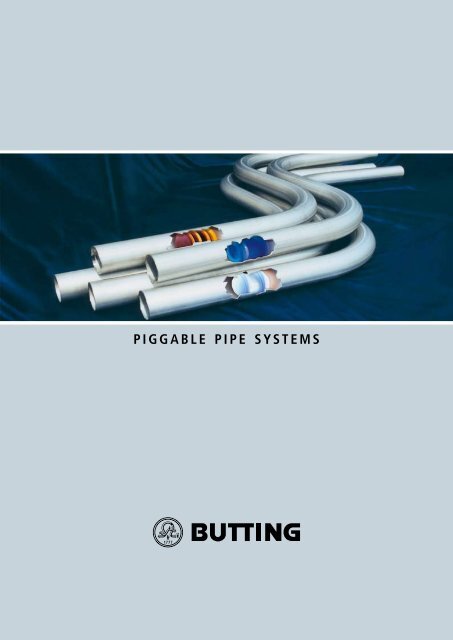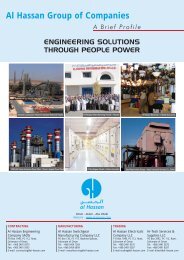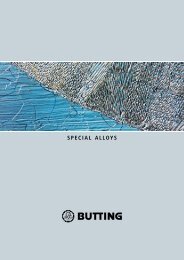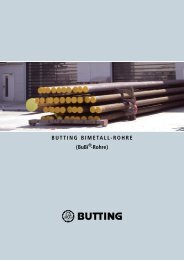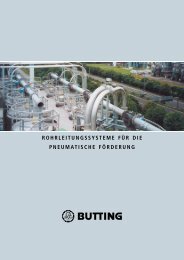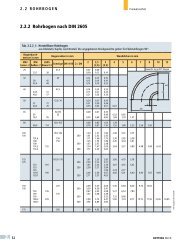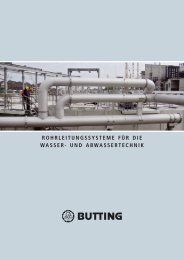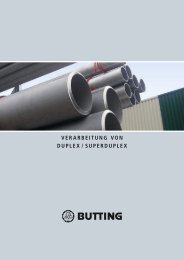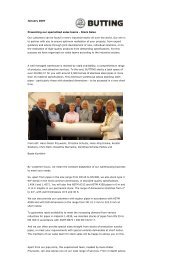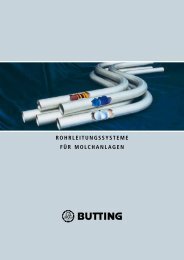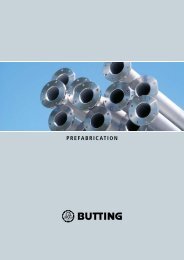PIGGABLE PIPE SYSTEMS - Butting GmbH & Co. KG
PIGGABLE PIPE SYSTEMS - Butting GmbH & Co. KG
PIGGABLE PIPE SYSTEMS - Butting GmbH & Co. KG
- No tags were found...
Create successful ePaper yourself
Turn your PDF publications into a flip-book with our unique Google optimized e-Paper software.
C O M PA N Y I N F O R M AT I O NBUTTING<strong>PIGGABLE</strong> <strong>PIPE</strong> <strong>SYSTEMS</strong>Worldwide customerproximityFor seven generations the name BUTTINGhas been standing for quality and flexibility.In 1777 BUTTING was founded asa coppersmithery by the ancestors ofthe today’s owner Hermann <strong>Butting</strong>. In1945 the family business moved its headquartersto Knesebeck and started theproduction of soldered and later on ofwelded copper pipes and linepipes. Atthe end of the fifties stainless steel graduallyreplaced copper as raw material forBUTTING products. Today, the familybusiness is run in the seventh generationand 1,300 employees process more than40,000 tons of stainless steel per year.BUTTING’s history is characterized by ahealthy and continuous growth based onenterprise and foresight. This principleProudly looking on our companyhistory of 230 yearsbrought Dr Hannshermann <strong>Butting</strong> toestablish an associated company inSchwedt on the Oder in 1991, after theGerman reunification. Today, BUTTINGin Schwedt is our expert’s unit for vesseland linepipe construction as well as forinternational assemblies.A team with visions (from left to right): Markus Bartsch, Hermann <strong>Butting</strong>,Dr Iris Rommerskirchen, Thomas Schüller, Dr Jens Peter LuxSince 2004 BUTTING has been representedin China. In Jiading, on the outskirts ofShanghai, we dispose of a production linefor pipework and individual items for theChinese market. It is our aim to enthuseour customers worldwide. This requires anareal proximity for particular services andproducts. For the very same reason wedecided to establish a branch in Canadain 2005. With BUTTING Canada in Calgarywe are able to provide Canadian customersmore quickly and more directly withour long-standing experience in the manufacturingof stainless steels.Our core competencesYour partner for longitudinally welded pipes and linepipesDuring the past years, BUTTING has investedin the latest manufacturing technology,environmental protection andquality assurance facilities at numerouslocations to extend our core competencesin the fields of material, forming andwelding technology. During the entirevalue added process we extensively takeinto consideration the material characteristicsof stainless steels. Our know-howand our expertise in surface techniquesguarantee BUTTING products with optimalcorrosion resistance.Worldwide quality standardSince the foundation of our company thereliable quality assurance is a distinctivepart of our company philosophy. Variousfields of application in different industrialsectors, such as the chemical plantconstruction, the aircraft and aerospaceindustry as well as the power engineeringand environmental and shipbuildingtechnology prove the high quality and reliabilityof our products.The constant development of newproducts and processes as well as theircontinuous improvement have a longtradition at BUTTING. For more than230 years, we have been facing tomorrow’schallenges in collaboration with ourcustomers, combining craftsmanship andengineering know-how under the motto“nothing is impossible”.
BUTTING<strong>PIGGABLE</strong> <strong>PIPE</strong> <strong>SYSTEMS</strong>C o n s t r u c t i o nProper realisationof the wall thicknessesIn addition to the deviation of the insidediameter it is extremely important tomaintain a minimum wall thickness or a“safe” wall thickness during the productionof welded piggable stainless steelpipes. In most cases a wall thickness of2 mm is sufficient, based on the pressureratings.As regards commonly used pipes acc.to DIN EN ISO 1127 T3 and acc. to DIN11850, a minus tolerance on the wallthickness of 10 % is permitted. For economicreasons, this tolerance is used upby the producers, hence in case of a nominalwall thickness of 2 mm, the actual wallthickness may go down to 1.8 mm.If one took such a pipe and made it intoan elbow with a general thinning of thewall of 20 % in the back of the elbow,then a remaining wall thickness of only1.4 mm would be very critical in an areawhich is especially dangerous in piggingtechnology.It so happened that due to maloperationof the system, a pig went right throughthe “thin” wall in the back of the elbow.With the introduction of the DIN 2430Bent piggable pipes from BUTTINGstandard prescribing relatively thick walls,this risk is reduced correspondingly (seetable 3).The weld geometryDuring the production of welded BUTTINGpiggable pipes the inside weld bead isrolled. This means that the inside weld isnearly flat to face for pipes up to NB 100and wall thicknesses of up to 3.6 mm. Asregards pipes of NB 200 and a wall thicknessof 4.5 mm, the maximum root reinforcementis only 0.25 mm, thus fulfillingthe requirements of the DIN 2430.<strong>Co</strong>mparison:Where commonly used stainless steelpipes acc. to DIN EN 1127, referringto DIN EN 10217-7, table 11 areconcerned, a root reinforcement of0.3 mm + 0.06 times the wall thicknessis allowed.It is also very important that the transitionzones from weld to parent metal aresmooth and free from undercuts. A weldreinforcement, sharp edges or undercutscan damage or even destroy the pigs.The quality of the cleaning may also beimpaired considerably.The lengths and ends ofthe pipesMeasurement of wall thicknessBUTTING piggable pipe 114.3 × 3.6 mm(magnification of 10 : 1)BUTTING piggable pipe 168.3 × 4.5 mm(magnification 10 : 1)Generally, the BUTTING piggable pipesare produced in lengths of 12 m, therebyreducing the number of circumferentialwelds which is a big advantage from aquality point of view. However, from aneconomical point of view, the reductionof circumferential welds and likewiseof flange connections is also crucial.In smaller process plants 6 m lengthsare also used. Generally, pipe ends arecut square and deburred. A special endpreparation, e. g. according to DIN 2559at the pipe mill should be recommendedif the pipes are to be welded together intheir supply lengths.
S u r f a c e sBUTTING<strong>PIGGABLE</strong> <strong>PIPE</strong> <strong>SYSTEMS</strong>Special requirementsto the insidesurfaceThe BUTTING piggable pipes are generallyproduced from cold rolled rawmaterials according to DIN EN 10088-2(execution 2B). The average roughnessof this material is approx. 0.4 micron.Taking into account irregularities of thesurface caused by tool marks during theproduction (DIN 10217-7), the roughnessof the finished pipes is < 0.8 micron.Due to the rolling operation of the weldalready described, a roughness value ofR a < 1.6 microns can be obtained. Roughnessmeasurements are carried out in thelongitudinal direction of the pipe (axialmeasurement). A radial measurement, asespecially required by the pharmaceuticalindustry, can be performed on request.The aformentioned roughness values canbe improved considerably by additionalgrinding, honing and/or electropolishing.The inside surfaces of the commonlyused pipes according to DIN EN ISO1127 are quite rough, as they are mainlyproduced from hot rolled raw materials(execution 1D / DIN EN 10088). As a rule,there are roughness values of approx.5 microns. Also seamless pipes showroughness values up to 4 microns owingto the production process used. Thesmoother the pipe inside surface, and theRoughness measurement of the insidesurfacePiggable pipes and elbows are used in many industrial branchessmaller the residual product quantitiesafter the pigging process, the better thecleanness of the entire pipeline.The constructionAs pigging plants are closed piping systemsin most cases, which have to betreated in accordance with the newpressure vessel rules, BUTTING producesits piggable pipes according to AD 2000-+ 10µm– 10+ 10µm– 10+ 10µm– 10Figure 3: <strong>Co</strong>mparison of roughness measurementMerkblatt W2 / DIN 10217-7, class 2. In ourview the application of less stringent testrequirements is not recommended.Remark: Part 3 of the DIN 2430 deals withthe testing and inspection of an entirepigging system before start of operation.It contains useful recommendations forthe pipe producers and end users withregard to the piggability and safety of theentire installation.Hot rolled parent metal(condition 1D acc. to DIN EN 10088-2)R a = 3.79 µmR z = 21.16 µmR max = 24.88 µm<strong>Co</strong>ld rolled parent metal(condition 2B acc. to DIN EN 10088-2)R a = 0.58 µmR z = 4.48 µmR max = 5.20 µmElectropolished pipe(cold rolled parent metal)R a = 0.26 µmR z = 1.71 µmR max = 2.40 µmNo guarantee for correctness<strong>Co</strong>mparison of Cut off : 0.8 mm Piggable piperoughness Direction : base material – longitudinal NB 80 / ID 82.5 × 3.2 mmmeasurement Location : pipe inside surface Grade 1.430710Average value Ra in microns1.000.900.800.700.600.500.400.00Figure 4: Roughness measurement with a production lotbase materialweld1425394653578498112126144158172186196214226240254pipe no.Piggable pipeID 82.5 × 3.2 mm, 1.4404,DIN 17457 Tab. 6 K2gNo guarantee for correctness
BUTTING<strong>PIGGABLE</strong> <strong>PIPE</strong> <strong>SYSTEMS</strong>E l b o w sVarious piggablepipe elbowsA prerequisite for optimum piggingresults in a pigging system is the use ofintegrated bends and individual elbowsmade from the same pipes as for thestraight lines. The tolerances on wallthickness and the inside diameters of thepipes and elbows are nearly identical asthey are all from the same heat and productionlot. Orbital welding can be performedwithout any problems, as thereare no internal misalignments.During the production of piggable pipebends it is important not to change thetolerances of the inside diameters of themother pipes unduly. The variations ofthe tolerances are directly linked withthe production process. Therefore, theSingle piggable elbowintegrated bends and elbows are generallymade according to DIN 2605 type 5(2.5 × D) by means of the special bendingmachines BUTTING has at its disposal.In order to ensure subsequent orbitalwelding, the elbows must be providedwith straight ends of a minimum of150 mm each.<strong>Co</strong>ntrol of the elbowtolerancesAs any deviations of the tolerances, especiallyin the bending area of the elbow,can only be determined by measuringthe outside diameter, relevant controlwas laid down in the DIN 2430 part 1,whereby the dimension of the motherpipe is always used as a reference. Theissuing of a dimension report is requiredaccording to this standard. Figure 5shows how the inside diameter changesduring the bending process.Production possibilities and tolerances canbe found in the table 4 on page 12.Bending process Bending process using rollers Bending process using a mandrilFigure 5: Progression of a diameter and wall thickness of a 90° elbowDiameter in mm9190898887868584838281M1 M2 M3 M4 M5 M6 M7 M8Measuring points uniformly dispersed over the bending area5432Example:size 88.9 × 3 mm,material grade 1.4404,acc. to DIN 2605 type 5Wall thickness in mmNo guarantee for correctnessOD A-A (vertical measurement)theoretic ID A-A *)OD B-B (hirizontal measurement)theoretic ID B-B *)wall thickness in the back of the elbowwall thickness, inner radius of elbowaverage wall thickness in the neutralbending zone*) The theoretic inside diameters are calculated by subtracting the measured wall thicknesses from the measuredoutside diametersMultiple bends are produced atBUTTING using a mandril11
p r e f a b r i c at i o nBUTTING<strong>PIGGABLE</strong> <strong>PIPE</strong> <strong>SYSTEMS</strong>Prefabrication accordingto customerspecificationsWelding-neck flanges with projectionand recessaccording to isometric drawings. Multiplebends having different angles and positionsare also possible. The bending radiiare in accordance with DIN 2605, type 5(see table 4).The installation of piggable pipelines onsite is generally carried out by joining thematerials by orbital welding or by usingspecial welding-neck flanges. Both arecovered by the DIN 2430-2. As regardsthe circumferential welds, the maximumtolerances on inside diameter, weld reinforcementand penetration cavity areprescribed. As to the flanges, a joint withprojection and recess is prescribed, ensuringoptimum alignment.In order to guarantee an excellent quality,prefabrication at the pipe producer’s millis highly recommended. In order to improvehe quality even further, we do not onlysupply the piggable pipes and elbows, butoffer the following additional services:a) Pipeline planning and isometricdrawingsThe basis of optimum prefabrication isthe provision of isometric drawings accordingto given diagrams, layouts, constructiondrawings and dimensions of thecomponents. It is therefore possible toimprove the later course of the piggablepipelines right from the planning stage.Circumferential welds and flange connectionsare reduced as much as possible,and integrated bends are used rather thanindividual elbows, which need to be fittedby welding.b) Piggable pipes with integratedbendsAt BUTTING integrated bends are producedon modern bending machinesTable 4: Production possibilities and tolerances for piggable elbows andintegrated bendsNBOD/ID(mm)Wallthickness(mm) 1Averageradius (mm)Tangent(mm) 2Toleranceof outsidediameter ofelbow 3Also asmultiplebends25 33.7 / 29.7 2.0 72.5 (DIN 2605/5) 150 / 150 + 0.5 up to – 1.0 % X25 33.7 / 29.7 2.0 300 (and above) 150 / 150 0.0 up to – 1.5 %50 60.3 / 54.5 2.9 135 (DIN 2605/5) 150 / 150 + 0.5 up to – 1.0 % X50 60.3 / 54.5 2.9 500 (and above) 150 / 150 0.0 up to – 1.5 %80 88.9 / 82.5 3.2 205 (DIN 2605/5) 150 / 150 + 0.5 up to – 1.0 % X80 88.9 / 82.5 3.2 500 (and above) 150 / 150 0.0 up to – 1.5 %100 114.3 / 107.1 3.6 270 (DIN 2605/5) 150 / 150 + 0.5 up to – 1.5 % X100 114.3 / 107.1 3.6 500 (and above) 150 / 150 0.0 up to + 1.5 %125 139.7 / 131.7 4.0 330 (DIN 2605/5) 150 / 150 + 0.5 up to – 2.0 % X125 139.7 / 131.7 4.0 500 (and above) 150 / 150 0.0 up to + 1.5 %150 168.3 / 159.3 4.5 390 (DIN 2605/5) 150 / 150 + 0.5 up to – 2.0 % X150 168.3 / 159.3 4.5 750 (and above) 150 / 150 0.0 up to + 1.5 %200 215.5 / 206.5 4.5 510 (DIN 2605/5) 150 / 150 + 0.5 up to – 2.5 %200 215.5 / 206.5 4.5 900 (and above) 150 / 150 0.0 up to + 2.0 %1Thinning of the wall in the back of the elbow approx. 20 %2Longer tangents are possible3Relating to the outside diameter of the mother pipe, including ovalityc) Full-body picklingFull-body pickling of the entire pipingcomponents is one of the big advantagesof prefabrication at the producer’s workshops.The removal of residual matterfrom the bending process, and tintingand contamination of the circumferentialwelds guarantee the necessary corrosionresistance of the material.No guarantee for correctness12Special pickling plant for piggable elbows with long radii to guarantee therequired surface quality
BUTTING<strong>PIGGABLE</strong> <strong>PIPE</strong> <strong>SYSTEMS</strong>Aerial view BUTTING Knesebeck1777C A N A D AH. BUTTING <strong>GmbH</strong> & <strong>Co</strong>. <strong>KG</strong>Gifhorner Straße 5929379 KnesebeckGermanyPhone: + 49 5834 50-0Fax: + 49 5834 50-320Email: info@butting.deBUTTING Anlagenbau<strong>GmbH</strong> & <strong>Co</strong>. <strong>KG</strong>Kuhheide 1316303 Schwedt / OderGermanyPhone: + 49 3332 2097-0Fax: + 49 3332 2097-18Email: info@butting-schwedt.deBUTTING Canada Ltd.239 Crawford Place<strong>Co</strong>chrane, AlbertaT4C 2G8CanadaPhone: + 1 403932 5844Fax: + 1 403932 4237Email: canada@butting.deInternet: www.butting.deMPE S. A.Avenue de Tyras 511120 BrusselsBelgiumBUTTING (Shanghai) <strong>Co</strong>., Ltd.Jingxue Rd. 199 / 2Malu Jiading201801 ShanghaiChinaBUTTING HongkongRepresentative Office1/F, Airport World Trade Centre1 Sky Plaza Road, HK International AirportHong Kong16Phone: + 32 2262 1010Fax: + 32 2262 0241Email: info@mpe.bePhone: + 86 21 69157598Fax: + 86 21 69157599Email: info@butting.com.cnPhone: + 852 3756 3651Fax: + 852 3756 3599Email: hongkong@butting.de


